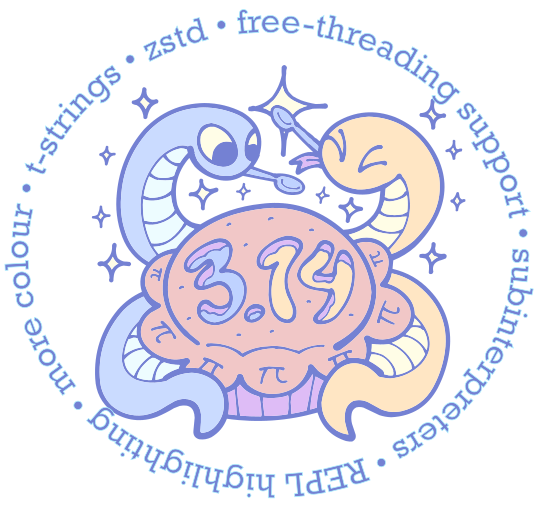Code at: https://github.com/villares/sketch-a-day/tree/main/2025/sketch_2025_12_09
More sketch-a-day: https://abav.lugaralgum.com/sketch-a-day
If you like this, support my work:
https://www.paypal.com/donate/?hosted_button_id=5B4MZ78C9J724
https://liberapay.com/Villares
https://wise.com/pay/me/alexandrev562 #Processing #Python #py5 #CreativeCoding
Code at: https://github.com/villares/sketch-a-day/tree/main/2025/sketch_2025_12_09
More sketch-a-day: https://abav.lugaralgum.com/sketch-a-day
If you like this, support my work:
https://www.paypal.com/donate/?hosted_button_id=5B4MZ78C9J724
https://liberapay.com/Villares
https://wise.com/pay/me/alexandrev562 #Processing #Python #py5 #CreativeCoding
I will be streaming on Twitch at <https://www.twitch.tv/glyph_official/> tomorrow at 12PM US/Pacific, which is in about 12 hours. Come by for some #Python coding in #Emacs and some shenanigans with desktop apps or the python warnings module and maybe some virtual machines.
Are there any software projects that people would be willing to pay a small weekly or monthly contribution to support me while I develop it? I need a way to feed my family, and I don't like asking for handouts.
Please respond with ideas of things you'd like to see exist, that you'd be willing to contribute an ongoing nonzero amount towards, and boost for reach. If you don't have idea of your own, that's fine. Boosting will still help!
#FediHired
#OpenSource
#Python
#MachineLearning
#Data
#Reporting
#BackendDeveloper
Are there any software projects that people would be willing to pay a small weekly or monthly contribution to support me while I develop it? I need a way to feed my family, and I don't like asking for handouts.
Please respond with ideas of things you'd like to see exist, that you'd be willing to contribute an ongoing nonzero amount towards, and boost for reach. If you don't have idea of your own, that's fine. Boosting will still help!
#FediHired
#OpenSource
#Python
#MachineLearning
#Data
#Reporting
#BackendDeveloper
urllib3 used "DeprecationWarning" for 3 years to deprecate API features and it didn't work, so what do we do instead?
#python #deprecation #deprecate #api
https://sethmlarson.dev/deprecations-via-warnings-dont-work-for-python-libraries
A retrospective of 2025: what I learned this year
https://blog.christophe-henry.dev/2025/12/07/retrospective-of-2025.html
Where I reflect on everything I worked on and learnt in 2025. I talk about my work on Django Template Compiler and my contributions to Django Rusty Templates, Mixxx and @yunohost.
How about you? What's your retrospective?
A retrospective of 2025: what I learned this year
https://blog.christophe-henry.dev/2025/12/07/retrospective-of-2025.html
Where I reflect on everything I worked on and learnt in 2025. I talk about my work on Django Template Compiler and my contributions to Django Rusty Templates, Mixxx and @yunohost.
How about you? What's your retrospective?
whats up, have you ever thought that programming languages are too anglocentric and wanted to write code top to bottom, right to left?
introducing vertical-python: https://pypi.org/project/vertical-python/
complete with a custom codec so your vertical python files are importable just like any other python file!
so long crummy old hello_world(), say hello to
hello_world()
whats up, have you ever thought that programming languages are too anglocentric and wanted to write code top to bottom, right to left?
introducing vertical-python: https://pypi.org/project/vertical-python/
complete with a custom codec so your vertical python files are importable just like any other python file!
so long crummy old hello_world(), say hello to
hello_world()
Just released! 🚀🐍
Python 3.14.1
Waiting for the .1 to upgrade? This one's especially for you!
🥧 Deferred type annotation evaluation!
🥧 T-strings!
🥧 Zstandard!
🥧 Syntax highlighting in the REPL!
🥧 Colour in unittest, argparse, json and calendar CLIs!
🥧 UUID v6-8!
🥧 And much more!
https://discuss.python.org/t/python-3-14-1-is-now-available/105163
Just released! 🚀🐍
Python 3.14.1
Waiting for the .1 to upgrade? This one's especially for you!
🥧 Deferred type annotation evaluation!
🥧 T-strings!
🥧 Zstandard!
🥧 Syntax highlighting in the REPL!
🥧 Colour in unittest, argparse, json and calendar CLIs!
🥧 UUID v6-8!
🥧 And much more!
https://discuss.python.org/t/python-3-14-1-is-now-available/105163



